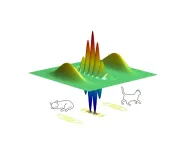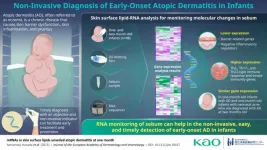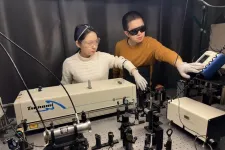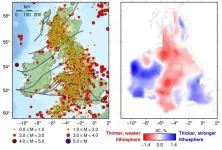(Press-News.org) INDIANAPOLIS – The pandemic has placed a spotlight on public health -- its workforce, infrastructure and underlying information systems designed to collect, analyze and manage public health data.
Informatics, health information technology and public health experts from across the nation convened at an American College of Medical Informatics symposium concluded that how information is received and shared by public health agencies is overdue for “a strategically designed, technology-enabled, information infrastructure for delivering day-to-day essential public health services and to respond effectively to public health emergencies.” Their report explores the strengths, weaknesses, opportunities and threats presented by public health information systems.
Among the nine strengths was the yeoman service performed by public health workers and officials who worked with the systems during the pandemic. A total of 22 weaknesses were detected. Additionally, 14 opportunities and 14 threats were also identified.
“We know from the pandemic that there were weaknesses in public health data systems and information technology -- many of which were developed in the 1990s or earlier and are outdated,” said Brian E. Dixon, PhD, MPA, Regenstrief Institute and Indiana University Fairbanks School of Public Health director of public health informatics, who co-chaired the symposium planning committee and is senior author of its report. “We saw that we were still collecting, sharing and managing information using fax machines. Hospitals, laboratories and others were faxing data to public health departments. It comes off the fax machine on paper and then has to be re-entered into a different system by a human being. And that's completely inefficient.
“Public health is nowhere as integrated as, for example, the banking system in this country. You can seamlessly move money from one bank to another or you can easily send money to someone. It's actually harder to send information in public health than it is to send money in our financial system.”
Dr. Dixon notes that while the HITECH, short for Health Information Technology for Economic and Clinical Health, Act of 2009 provided a more than $30 billion investment in the healthcare system to support adoption of electronic health records, investments have not been made in public health. That type of investment would bring about the same kind of transformation, enabling the U.S. to be better prepared for the next pandemic or even the next measles outbreak in a given state.
He observed, “It's not simple enough to program the computer to do something. We have to develop systems in ways that facilitate human work. The goal of public health is to understand where disease is in the community, trying to engage communities in being healthier and preventing disease, but also connecting people to care when they need it so they can get care when they need it.
“We're at a point as the pandemic wanes where we can now be reflective. We can look back over the last couple of years and see what went well and what didn't. We can learn from that experience, and then feed that knowledge into recommendations on how to prepare, update and scale our systems for the future.”
Additionally, Dr. Dixon notes that in many state and local health departments there are systems that collect information from various sources including hospitals, doctors’ offices, laboratories, the public and even restaurants. Systems collect data on sexually transmitted infections, on communicable diseases, on chronic illnesses, on injuries among people who present at the emergency department, and on foodborne illness. All these systems exist in silos and are not connected. These systems, he says, need updating to be interactive, flexible, scalable, data driven and to support mobile applications.
In the symposium report, the experts present three actionable elements to build upon strengths and opportunities while addressing weaknesses and threats:
addressing the needs for sustainable funding,
leveraging existing infrastructure and processes for information exchange and system development that meets public health goals,
preparing the public health workforce to benefit from available resources.
“Strengths, weaknesses, opportunities, and threats for the nation's public health information systems infrastructure: synthesis of discussions from the 2022 ACMI Symposium” is published in JAMIA.
Authors: Jessica C. Acharya1, Catherine Staes2,3, Katie S. Allen4,5, Joel Hartsell3,6, Theresa A. Cullen5,7, Leslie Lenert8,9, Donald W. Rucker10,11, Harold P. Lehmann12, Brian E. Dixon4,5
Affiliations
1Healthy Policy & Management, Informatics, Johns Hopkins Bloomberg School of Public Health, Baltimore, Maryland, USA.
2College of Nursing, University of Utah, Salt Lake City, Utah, USA.
3School of Medicine, University of Utah, Salt Lake City, Utah, USA.
4Department of Health Policy & Management, Richard M. Fairbanks School of Public Health, IUPUI, Indianapolis, Indiana, USA.
5Center for Biomedical Informatics, Regenstrief Institute, Inc., Indianapolis, Indiana, USA.
6Epi-Vant, LLC., Salt Lake City, Utah, USA.
7Pima County Public Health Department, Tucson, Arizona, USA.
8Department of Medicine, Medical University of South Carolina, Charleston, South Carolina, USA.
9Health Sciences South Carolina, Charleston, South Carolina, USA.
101upHealth, Boston, Massachusetts, USA.
11Department of Emergency Medicine, Ohio State University, Columbus, Ohio, USA.
12Department of Medicine, Johns Hopkins School of Medicine, Baltimore, Maryland, USA.
About Brian E. Dixon, PhD, MPA
In addition to his roles as interim director of the Regenstrief Institute’s Clem McDonald Center for Biomedical Informatics and director of public health informatics for Regenstrief Institute and Indiana University Richard M. Fairbanks School of Public Health, Brian E. Dixon, PhD, MPA, is a professor of epidemiology at the Fairbanks School of Public Health. He is also an affiliate scientist at the U.S. Department of Veterans Affairs Health Services Research and Development Center for Health Information and Communication, Richard L. Roudebush VA Medical Center.
About Regenstrief Institute
Founded in 1969 in Indianapolis, the Regenstrief Institute is a local, national and global leader dedicated to a world where better information empowers people to end disease and realize true health. A key research partner to Indiana University, Regenstrief and its research scientists are responsible for a growing number of major healthcare innovations and studies. Examples range from the development of global health information technology standards that enable the use and interoperability of electronic health records to improving patient-physician communications, to creating models of care that inform practice and improve the lives of patients around the globe.
Sam Regenstrief, a nationally successful entrepreneur from Connersville, Indiana, founded the institute with the goal of making healthcare more efficient and accessible for everyone. His vision continues to guide the institute’s research mission.
About the IU Richard M. Fairbanks School of Public Health
Located on the IUPUI and Fort Wayne campuses, the IU Richard M. Fairbanks School of Public Health is committed to advancing the public’s health and well-being through education, innovation, and leadership. The Fairbanks School of Public Health is known for its expertise in biostatistics, epidemiology, cancer research, community health, environmental public health, global health, health policy, and health services administration.
END
Connecting the dots: Leveraging information to improve the nation’s public health
National experts identify public health infrastructure’s strengths, weaknesses, opportunities, threats
2023-06-08
ELSE PRESS RELEASES FROM THIS DATE:
Schrödinger’s cat makes better qubits
2023-06-08
Quantum computing uses the principles of quantum mechanics to encode and elaborate data, meaning that it could one day solve computational problems that are intractable with current computers. While the latter work with bits, which represent either a 0 or a 1, quantum computers use quantum bits, or qubits – the fundamental units of quantum information.
“With applications ranging from drug discovery to optimization and simulations of complex biological systems and materials, quantum computing has the potential to reshape vast areas of science, industry, and society,” says ...
A novel way to diagnose early-onset atopic dermatitis using sebum
2023-06-08
Eczema is an inflammatory skin condition that often affects infants as young as one to two months. Among the various types of eczema seen in infants, early-onset atopic dermatitis (AD), characterized by psychological stress and sleep disorders, is particularly concerning. Studies have, in fact, identified that if left untreated, AD can increase the risk of allergic diseases such as food allergies and asthma—a progression also known as the “atopic march”. Early diagnosis and intervention of early-onset AD is needed to ensure the infant’s psychological and physical ...
Aviation turbulence strengthened as the world warmed — study
2023-06-08
The skies aircraft fly through are bumpier today than four decades ago, scientists have found, after producing a new analysis showing that turbulence has increased as the climate changed.
New research from the University of Reading shows that clear-air turbulence, which is invisible and hazardous to aircraft, has increased in various regions around the world.
At a typical point over the North Atlantic – one of the world’s busiest flight routes – the total ...
Giving parents better school quality data encourages them to consider less affluent, less white schools -- To a Point
2023-06-08
Washington, June 8, 2023—For years, parents looking for data to compare the academic quality of schools for their children had one primary measure to turn to: average student scores on standardized tests. However, these scores are often related to factors that have nothing to do with instructional quality—such as family income or racial and ethnic background—and push parents toward schools that are Whiter and more affluent, exacerbating school segregation in the U.S. As a result, many education ...
UMass Amherst epidemiologist updates and validates ‘gold standard’ of prenatal physical activity tools
2023-06-08
A University of Massachusetts Amherst public health researcher has updated and validated the widely used Pregnancy Physical Activity Questionnaire (PPAQ) to improve the measurement performance of this self-report physical activity method.
Lisa Chasan-Taber, professor and chair of biostatistics and epidemiology, and her research group used novel and innovative tools – an advanced accelerometer and wearable camera – to assess PPAQ performance. The researchers developed the PPAQ in 2004 as the first validated pregnancy physical activity questionnaire. Listed on the UMass Amherst timeline ...
Researchers tune thermal conductivity of materials ‘on the fly’ for more energy-efficient devices
2023-06-08
A team led by University of Minnesota Twin Cities scientists and engineers discovered a new method for tuning the thermal conductivity of materials to control heat flow ”on the fly.” Their tuning range is the highest ever recorded among one-step processes in the field, and will open a door to developing more energy-efficient and durable electronic devices.
The researchers’ paper is published in Nature Communications, a peer-reviewed scientific journal covering the natural sciences.
Just as electrical ...
Topological phase protection reams to sub-symmetry
2023-06-08
An international team led by researchers at Nankai University in China and at University of Zagreb in Croatia, along with team at the Institut national de la recherche scientifique (INRS) in Canada, led by Roberto Morandotti has made an important breakthrough in the study of topological phases. Their findings were recently published in Nature Physics – a journal published by Nature Publishing Group.
In the last decade, topological photonics has attracted increasing attention due to the unique prospects to achieve light manipulation with high performance in terms of robustness and stability. Discoveries in topological photonics ...
Identifying the cause of heart muscle disease in children is key to effective treatment
2023-06-08
Statement Highlights:
A new American Heart Association scientific statement focuses on treatment strategies for pediatric cardiomyopathy (diseases of the heart muscle’s structure and function that may lead to heart failure and death) and is a companion to a 2019 scientific statement focused on diagnosis of the condition.
There are several types of cardiomyopathies in children, and treatment should include personalized therapies based on the root cause, symptoms and progression of the condition in each child, according to the new scientific statement.
Embargoed until 4 a.m. CT/5 a.m. ET, Thursday, June 8, 2023
DALLAS, June 8, 2023 — Treating ...
Why earthquakes happen more frequently in Britain than Ireland
2023-06-08
Researchers from the University of Cambridge and the Dublin Institute for Advanced Studies have discovered that variations in the thickness of tectonic plates relate directly to the distribution of earthquakes in Britain, Ireland and around the world.
The study also solves an enduring mystery as to why small earthquakes happen frequently in Britain but are almost completely absent from neighbouring Ireland.
The researchers produced a computer-generated image of Earth’s interior using a technique called seismic tomography, which works in a similar way to a medical CT scan. The data they collected revealed variations in the thickness of the ...
Greenhouse gas emissions at ‘an all-time high’ - and it is causing an unprecedented rate of global warming, say scientists
2023-06-08
University of Leeds Press Release
Under embargo until 09.00 am (British Summer Time) on Thursday, June 8
**With details of a linked press conference at the UNFCC meeting in Bonn - see under notes to journalists**
Greenhouse gas emissions at ‘an all-time high’ - and it is causing an unprecedented rate of global warming, say scientists
Human-induced ...
LAST 30 PRESS RELEASES:
University of Phoenix College of Doctoral Studies releases white paper on AI-driven skilling to reduce burnout and restore worker autonomy
AIs fail at the game of visual “telephone”
The levers for a sustainable food system
Potential changes in US homelessness by ending federal support for housing first programs
Vulnerability of large language models to prompt injection when providing medical advice
Researchers develop new system for high-energy-density, long-life, multi-electron transfer bromine-based flow batteries
Ending federal support for housing first programs could increase U.S. homelessness by 5% in one year, new JAMA study finds
New research uncovers molecular ‘safety switch’ shielding cancers from immune attack
Bacteria resisting viral infection can still sink carbon to ocean floor
Younger biological age may increase depression risk in older women during COVID-19
Bharat Innovates 2026 National Basecamp Showcases India’s Most Promising Deep-Tech Ventures
Here’s what determines whether your income level rises or falls
SCIE indexation achievement: Celebrate with Space: Science & Technology
Children’s Hospital Colorado performs region’s first pediatric heart and liver dual organ transplant
Australian team discover why quantum computers have memory problems over time
What determines the fate of a T cell?
Candida auris: genetic process revealed which could be treatment target for deadly fungal disease
Groundbreaking discovery turns household plastic recycling into anti-cancer medication
Blocking a key inflammatory pathway improves liver structure and vascular function in cirrhosis, study finds
Continuous spread: Raccoon roundworm detected in nine European countries
HKUST Engineering researchers developed a novel photodetector to enhance the performance of on-chip light monitoring
Strategic river sensors could have forewarned of Texas Camp flood disaster
Drone sampling of whale breath reveals first evidence of potentially deadly virus in Arctic
Roman soldiers defending Hadrian’s Wall infected by parasites, study finds
Pinochet’s prisoners were tormented with music but still found solace in it, a new book reveals
Fertility remains high in rural Tanzania despite access to family planning
AI-assisted device can improve autism care access
Kinetic careers
Uncovering how parasitic plants avoid attacking themselves to improve crop resistance
Nanoparticle vaccine strategy could protect against Ebola and other deadly filoviruses
[Press-News.org] Connecting the dots: Leveraging information to improve the nation’s public healthNational experts identify public health infrastructure’s strengths, weaknesses, opportunities, threats






